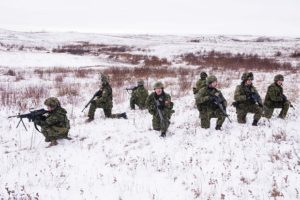By Capt. Graham Kallos
Wainwright, AB— Wainwright, and November. Two words that, when uttered to a member of the Canadian Army, will usually result in a long-distance stare and a grimace.
The fourth annual Canadian Patrol Concentration will see 26 teams, each comprised of eight soldiers, deploy to the Wainwright Training Area in order to participate in a grueling test of their ability to conduct a patrol behind simulated enemy lines for up to 48 hours – all while being hunted by fellow Canadian Army soldiers playing the role of an enemy force from November 18 to 27, 2016.
Chief Warrant Officer Michael Forest, a Canadian Army Infantry soldier with over 26 years of service, including multiple international deployments, is currently serving as the Sergeant Major for the Operations Group of the Canadian Manoeuvre Training Centre.
He defines a patrol as “a detachment sent out from a unit to perform an assigned mission of reconnaissance or combat or a combination of both. Patrols will vary in size from as little as three personnel up to a company in strength. Patrolling is carried out by day and by night, in all types of operations.”
For Canadian Army soldiers, this means they must be able to operate in all forms of terrain, some of which cause issues for military vehicles, so they must be capable of operating independently of their unit, and on foot.

“Mountains, the Arctic, and other such environments can cause barriers to mobility, as well as logistical issues for resupply and medevac for deployed units,” said CWO Forest. “The Canadian Patrol Concentration provides an opportunity for soldiers, be they from the Infantry or one of the affiliated Combat Arms enablers, to test the skills required to conduct a patrol with minimal mechanized support.”
Located in a remote area of eastern Alberta, the Wainwright Training Area measures over 600 km² and contains all the elements required to make it a challenging area in which to navigate and operate. From terrain that varies significantly in elevation, vegetation, and moisture, to the unpredictable seasonal weather patterns that come with being in the Canadian Prairies, the Wainwright Training Area provides an exceptional venue for testing the mettle of the 2016 Canadian Patrol Concentration participants.
Participants will be scored on their ability to conduct the battle procedure, issue orders, how they carry out their insertion into “enemy territory”, and how they overcome challenging tests placed along their patrol route. Once stressors such as time restrictions, weather and terrain are added, the basic tasks that they will be required to carry out while on their roughly 35 km patrol become that much harder.
“This patrol concentration is designed to be tough. Without the use of GPS, participants will need to deal with obstacle crossings, reconnoitre an objective, conduct meeting engagements with friendly and enemy forces, engage with direct and indirect fire and administer first aid and manage casualty extraction,” stated CWO Forest. “They will need to rely on discipline, camouflage and concealment, security, basic field skills and communications – all of which are essential building blocks that every Canadian Army soldier should be good at.”
The typical rank-spread of a patrol ranges from Private to Sergeant. The experiences gained from working through the Canadian Patrol Concentration as a team will pay dividends down the road. It is expected that participants will return to their home units better soldiers for having participated in the concentration.
“Some of the key leadership skills we wish our Non-Commissioned Members to possess will be challenged throughout the concentration. Motivating, guiding, making smart decisions despite being tired, cold, and hungry, will challenge the fortitude of every member of the patrol,” said CWO Forest. “I have learned that if you are able to be strong in body, mind, and spirit, you will be able to push through the adversity. Ultimately, the successful members of the patrol will look back with great pride on their accomplishment.”
Capt. Graham Kallos is with the Canadian Manoeuvre Training Centre Public Affairs